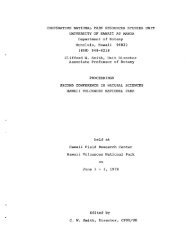american samoa - University of Hawaii at Manoa
american samoa - University of Hawaii at Manoa
american samoa - University of Hawaii at Manoa
Create successful ePaper yourself
Turn your PDF publications into a flip-book with our unique Google optimized e-Paper software.
similar forest is probably found on the same kind <strong>of</strong><br />
slopes below the cliffs on the main part <strong>of</strong> Ofu,<br />
<strong>of</strong>ten mixed with lowland forest trees. This area is<br />
further discussed below.<br />
'Two other significant small trees are found here.<br />
Chionanthus vitiensis is a new record for American<br />
Samoa, and was collected on Tutuila (V<strong>at</strong>ia) and on<br />
Ofu. It is known from only two records in Western<br />
Samoa; only a single tree was found in each <strong>of</strong> these<br />
four records. Erv<strong>at</strong>amia obtusiuscula is uncommon<br />
on Ofu, and has not been collected on Tutuila since<br />
1894. Both <strong>of</strong> these species should be considered to<br />
be rare in American Samoa.<br />
The littoral forest on the sandy beach was differ-<br />
ent in species composition. In most places it is<br />
highly disturbed and domin<strong>at</strong>ed by planted and<br />
n<strong>at</strong>uralized coconuts. At the east end this was a<br />
mixture <strong>of</strong> coconuts and Hernandia nymphaeifolia,<br />
which were sh<strong>at</strong>tered by one or more <strong>of</strong> the recent<br />
hurricanes. Also present on the beach is Terminalia<br />
samoensis (talie), which is not present in the Tutuila<br />
park unit. The west end <strong>of</strong> the beach, just to the east<br />
<strong>of</strong> the airstrip, is rocky and narrow (between the<br />
beach and the road), and is domin<strong>at</strong>ed by a combi-<br />
n<strong>at</strong>ion <strong>of</strong> Hernandia nymphaeifolia, Thespesia<br />
populnea (Pacific rosewood, milo), Barringtonia<br />
asi<strong>at</strong>ica, and Hibiscus tiliaceus. Much less common<br />
there are Terminalia c<strong>at</strong>appa, Morinda citrifolia,<br />
Guettarda speciosa, Macaranga harveyana, and<br />
Erythrina varieg<strong>at</strong>a.<br />
4. Coastal Marsh<br />
The wetland situ<strong>at</strong>ion on Ofu is similar to th<strong>at</strong> on<br />
'htuila: on both there is a coastal marsh just outside<br />
the boundaries <strong>of</strong> the park. But since this is an<br />
important type <strong>of</strong> veget<strong>at</strong>ion, and it is so close to the<br />
park, it is discussed here. Although the two marshes<br />
are similar in their geological structure, they differ<br />
gre<strong>at</strong>ly in their veget<strong>at</strong>ion. While the V<strong>at</strong>ia marsh<br />
has been abandoned, the one on Ofu is actively<br />
being cultiv<strong>at</strong>ed. It was, th<strong>at</strong> is, until storm waves <strong>of</strong><br />
a recent hurricane swept across it. Today it is still<br />
mostly barren mud, probably unable to support a<br />
n<strong>at</strong>ive marsh or cultiv<strong>at</strong>ed taro because <strong>of</strong> the<br />
residual salt concentr<strong>at</strong>ion. It is a habit<strong>at</strong> for n<strong>at</strong>ive<br />
ducks (toloa).<br />
Originally the veget<strong>at</strong>ion was domin<strong>at</strong>ed by<br />
Eleocharis dulcis, possibly in combin<strong>at</strong>ion with<br />
Cyclosorus interruptus, and these species will<br />
probably return to domin<strong>at</strong>e the uncultiv<strong>at</strong>ed<br />
portions <strong>of</strong> the marsh. Also present is the small<br />
fragrant herb Limnophila fragrans. This plant is<br />
currently known in the territory only from the Ta'<br />
village marsh, the Ofu marsh, the Olosega marsh,<br />
and the V<strong>at</strong>ia marsh, and should be considered rare<br />
in Samoa. It is probably even rarer in Western<br />
Samoa. It was found to be present in small quan-<br />
tities in the brackish mud <strong>of</strong> Ofu marsh, and will<br />
probably become more common as the marsh<br />
returns to its normal st<strong>at</strong>e.<br />
5. Lowland Forest<br />
The lowland forest within the park is disturbed<br />
-on the gentler slopes by past and present agri-<br />
culture, and on the steeper slopes by landslips. A<br />
plot was sampled in this veget<strong>at</strong>ion in the 1976<br />
survey (Whistler 1980) on the talus slope east <strong>of</strong> the<br />
airstrip (Appendix B: plot no. 14, modified from the<br />
original to correspond to the methods used in the<br />
present study). The dominant species in th<strong>at</strong> plot<br />
were Hibiscus tiliaceus (18% rel<strong>at</strong>ive dominance),<br />
Dysoxylum samoense (1 8%), Terminalia c<strong>at</strong>appa<br />
(13%), Myristica f<strong>at</strong>ua (12%), Neonauclea forsteri<br />
(1 I%), Guettarda speciosa (1 I%), and Diospyros<br />
samoensis (8%). Other species noted to be present<br />
on the slopes and cliffs during the June 1992 survey<br />
are Pisonia grandis, Sterculia fanaiho, Pometia<br />
pinn<strong>at</strong>a, and Ficus obliqua.<br />
This veget<strong>at</strong>ion is best classified as a disclimax<br />
lowland forest and probably best corresponds to the<br />
"Dysoxylum lowland forest on talus slopes and<br />
cliffs" noted in the Ta'u report (Whistler 1992b) as<br />
occurring in similar situ<strong>at</strong>ions on th<strong>at</strong> island. It is<br />
also similar to the veget<strong>at</strong>ion in the Tutuila park<br />
between Alava Ridge road and Fagas, and probably<br />
on the steep slopes <strong>of</strong> Alava Ridge above Pago Pago<br />
(which are mostly outside the Tutuila park<br />
boundaries).<br />
MONTANE FOREST<br />
The veget<strong>at</strong>ion on top <strong>of</strong> the ridge above the Ofu<br />
park area was also briefly examined. The top <strong>of</strong> the<br />
island has been extensively disturbed by past and<br />
recent agriculture and by the recent hurricanes.<br />
There is also a road leading from Ofu village up to<br />
the summit <strong>of</strong> the island (Mt. Tumu) to a microwave<br />
st<strong>at</strong>ion.<br />
Since the summit is <strong>at</strong> 500 m elev<strong>at</strong>ion, the forest<br />
is or was probably best classified as montane forest,<br />
similar to th<strong>at</strong> on Tutuila, but with fewer species. In
















